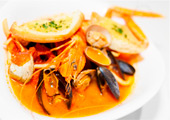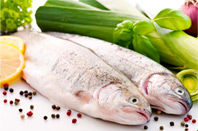A Focus on Quality – The Ingredients of Quality Management
It is safe to say, that everything that has to do with the production of goods and the provision of services nowadays relies on a functioning quality management system. In order to be able to understand this statement more clearly, one must first familiarize oneself with the basic concepts of quality assurance and quality management.
 Let’s take a look at the example of a head chef in a restaurant, the Chez CAQ. He turns groceries (raw materials) that he receives from suppliers into meals (products), which he then sells to his guests (customers). In order to ensure that nothing goes wrong in the process, the meals are always tasty, and the guests are always satisfied, the head chef every day conducts quality assurance and quality management.
Let’s take a look at the example of a head chef in a restaurant, the Chez CAQ. He turns groceries (raw materials) that he receives from suppliers into meals (products), which he then sells to his guests (customers). In order to ensure that nothing goes wrong in the process, the meals are always tasty, and the guests are always satisfied, the head chef every day conducts quality assurance and quality management.
Our head chef is on his way home from a visit to his good friend Claude in Southern France. The Provence in summer, the lavender fields, the small alleyways in Marseille – what a dream. And Claude’s tasty fish soup – absolutely excellent!
The Planning
Fortunately, Claude had given him the recipe. “That would be just the right thing for the menu next week” the head chef thinks to himself on the flight back home, and begins to ponder how to best make the soup. As in all things in life, the head chef first needs a thorough, well thought through plan: the overall timing, the most efficient procedures and the best resources. In short, who should do what when (APQP.Net – Process Management / APQP)?
 “That’s just the way I’ll do it!” the head chef thinks to himself. “But, 7 different types of fish, 8 different spices…A lot can go wrong there”. He starts to weigh up what could go wrong and how serious the consequences would be. “Not enough salt? No problem, I can add some more later. But, spoilt fish and guests with food poisoning? No, that must not happen!” (Risk.Net – Risk Management / FMEA)
“That’s just the way I’ll do it!” the head chef thinks to himself. “But, 7 different types of fish, 8 different spices…A lot can go wrong there”. He starts to weigh up what could go wrong and how serious the consequences would be. “Not enough salt? No problem, I can add some more later. But, spoilt fish and guests with food poisoning? No, that must not happen!” (Risk.Net – Risk Management / FMEA)
Through experience our head chef knows, that it is best to inspect the quality of goods as soon as they are delivered. This ensures that he can quickly identify possible faults: “The earlier I detect something, the faster I can react” (Compact.Net – Inspection Planning / Quality Inspection / SPC).
The First Steps
The plane has landed and our head chef has arrived at his home. He is confident that he has considered all relevant factors and heads off to bed. In the middle of the night he suddenly wakes up and thinks to himself: “Have I really thought of everything? Will things work in our kitchen the way I envisage it? Will I manage to make every soup taste the same and can I ensure that they are all equally good? All of this in the tremendous hustle and bustle that often goes on in our kitchen? What about the manager of the restaurant…will he be happy with everything? He does always have a very sharp eye on the numbers”. Our head chef therefore decides to test his new dish under realistic circumstances the next day, and present his findings to the manager (EMP.Net – Initial Sample Inspection).
After he has presented his findings to the manager and received the go-ahead for his new dish, our head chef starts to brief the kitchen staff. “The monkfish is a rather complicated fish…I want you to know that I only want the tail meat of the monkfish in my soup, and that you ensure you really remove all the skin off the red scorpion fish before adding it to the soup!”. He creates an instruction for each of the fish: How each fish is to be prepared and what individual characteristics must be considered. “OK, this is your homework” he says and hands out the instructions to the kitchen staff “and make sure that you read them carefully!” (QBD.Net – Document Management; Qualify.Net – Training Management).
 While our head chef is handing out the instructions, he pauses to think about his fishmonger. He has never really had any problems with the fishmonger’s deliveries – but in the past all he had ordered were frozen fish fingers and cod fillet. His new dish, however, requires seven all new types of fish, which, on top of that, are delivered in shape of the whole, unprocessed fish (SRM.Net – Supplier Management).
While our head chef is handing out the instructions, he pauses to think about his fishmonger. He has never really had any problems with the fishmonger’s deliveries – but in the past all he had ordered were frozen fish fingers and cod fillet. His new dish, however, requires seven all new types of fish, which, on top of that, are delivered in shape of the whole, unprocessed fish (SRM.Net – Supplier Management).
From experience he knows what to look out for when checking the quality and freshness of fish: they must smell of the sea, the eyes must be clear, the gills must be red, and the scales must be firmly attached to the fish. These are the four primary criteria that he wants to check as soon as the delivery arrives. He creates an inspection plan that includes these four criteria and by what means they should be inspected (Compact.Net – Inspection Planning / Quality Inspection / SPC).
“And our cold storage must always function correctly – considering the prices we will be paying for the fish, we cannot afford any malfunctions. Best we create a fixed maintenance plan for our cold storage” (PMS.Net – Preventive Maintenance). Our head chef is confident that he has now considered all factors that are relevant for the preparation of his new dish.
The Preparation
The day has arrived and the menu now right at the top features Bouillabaisse Marseillaise prepared with seven types of fish. Early in the morning the fishmonger delivers the fish. The freshness criteria are inspected immediately (Compact.Net) and the fish is then placed into the perfectly functioning +2 degrees Celsius cold storage (PMS.Net). It’s now lunchtime and the first orders for Bouillabaisse Marseillaise are coming in.
But what’s that? Some of the meals are being returned by the waiting staff. One guest complains that the soup is too salty and another one complains that it is not salty enough (REM.Net – Complaint Management / CAPA). What might be the cause of this? The food taster checks every meal before it leaves the kitchen. What’s wrong with him? An allergy or a cold? Or has he secretly started smoking again? That will have to be clarified (PMM.Net – Gauge Management).
 The Improvements
The Improvements
After a brief inspection it turned out that the food taster was indeed secretly smoking out the back of the restaurant and that the new salt shakers that had been ordered were not dispensing salt evenly. The head chef now takes all the feedback and complaints and uses it to design additional inspection plans (Linking of REM.Net and Compact.Net). He can now monitor the new processes and quickly react to all changes in the workflow: inspect newly delivered kitchen utensils or give the food taster a slap on the wrist if he catches him smoking. This efficient quality assurance cycle helps improve the restaurant and make it and the Bouillabaisse popular way beyond the limits of the city ….all the way to the office of the famous ‘The Taste of Quality’ magazine.
And presto! One of the magazine’s restaurant reviewers turns up at the Chez CAQ. “They always look very closely at the quality and like it if one can provide complete documentation of everything” the head chef knows. Of course the head chef can provide comprehensive documentation that proves all his processes and inspection plans work faultlessly (QBD.Net), but an additional check of everything would probably be advisable nonetheless (QAM.Net – Audit Management). Reminding all the staff of their jobs and duties is also very important at this point “I really don’t want anything to go wrong there!” (JobControl.Net – Action and Escalation Management).
The Success
The restaurant reviewer has a good look around the restaurant and quickly notices that all processes are tightly structured down to the smallest detail and nothing is left to chance. The restaurant can rapidly react to any change or extraordinary situation (Change.Net – Change Control) and all employees are always up-to-date with everything and perfectly trained (Qualify.Net). In light of this, the fact that the famous Chez CAQ Bouillabaisse Marseillaise tastes excellent is not at all surprising.
With a big smile on his face the reviewer awards the prestigious ‘Star’ of the famous ‘The Taste of Quality’ magazine and says that he has never seen such a perfectly functioning restaurant. “I’m sure the manager of the restaurant will love to hear about this as soon as possible” the head chef thinks to himself. “I think I’ll attach a photo of the ‘Star’ to this week’s report, along with the accounts and all the other important information of the day” (Success.Net – Key Performance Indicator Management).
 While our head chef is enjoying his well-earned after work relaxation, he lets the events of the day pass by and thinks about how tremendously important efficient quality assurance is for the success of the restaurant. The planning of processes, the inspection of incoming goods, the training of the staff, the maintenance of equipment…without all these measures the Chez CAQ would definitely not have received its ‘Star’.
While our head chef is enjoying his well-earned after work relaxation, he lets the events of the day pass by and thinks about how tremendously important efficient quality assurance is for the success of the restaurant. The planning of processes, the inspection of incoming goods, the training of the staff, the maintenance of equipment…without all these measures the Chez CAQ would definitely not have received its ‘Star’.
The Conclusion
“Ensuring that a consistent level of quality is maintained is like making a soup” the head chef thinks to himself. “You must have a good recipe, ensure that only the best ingredients are used, and take care that the soup is always salted just right. I need to know if a guest is not happy with his meal and must always be able to find out directly why this might be. Only if the quality is always maintained will the guests be satisfied and the restaurant is successful.”
We at CAQ AG know that regardless of what area a company may operate in – whether automobiles or medical equipment, whether service industry or heavy machinery, whether small business or major global corporation – consistently maintaining a high degree of quality is always of paramount importance. CAQ AG Factory Systems – your partner in the hunt for your ‘Star’ of quality.
Short Film – The Ingredients of Quality Management
Additional Links